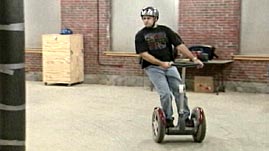In the seventeenth century, Isaac Newton laid out three laws according to which all objects move when acted on by gravity or some other force. These laws remain applicable today, although Albert Einstein showed that they are valid only when objects are moving much slower than the speed of light. Newton's first law of motion states that an object at rest or moving with constant velocity remains so unless acted on by some outside force. Newton's second law states that an object accelerates in the direction of a force acting on it in proportion to the magnitude of the force; the greater the force, the greater the acceleration. Newton's third law states that if a first object pushes or pulls on a second one, the second one pushes or pulls back on the first; interaction is never just one way.
Wheeled vehicles, like the Segway Human Transporter featured in this video, are designed with these fundamental laws in mind. In fact, the laws of nature are the foundation for all fields of engineering. When considering the question, for example, of how a wheeled vehicle gets the force it needs to move, the answer is rooted in Newton's third law of motion.
A wheel can be made to roll in one of two ways: by directly applying a force to the wheel -- as by the push of a hand -- or by applying a torque to its axle. (A torque is a rotational force that can be applied by a motor or pedal connected to an axle.) The applied force alone is not enough to cause the wheel to roll, however. Resistance provided by a type of friction, called static friction, is also needed. Friction is a force that resists motion when two objects are in contact. Static friction is resistance that keeps an object from sliding against a surface. For a wheel on a road surface, static friction exists where the tire tread contacts the ground. Push on a wheel in the absence of static friction, and it will slide along the ground.
With any wheeled vehicle, the challenge is to accelerate a mass. At rest, the Segway exerts a force -- the amount of which is dependent on its mass -- downward onto the ground. The ground exerts an equal but opposite force upward onto the device, thus supporting the Segway in the same way it supports all objects in an application of Newton's third law.
To begin to move, the Segway must accelerate. It therefore needs a force applied to it horizontally in the direction it will move. This force comes from an electric motor that powers the wheels' axle. The motor tries to turn the wheels, but the tires are in contact with the ground and don't slide because of the static friction. When enough force is applied, the motor causes the tires to push backward on the ground. In response, the ground pushes forward on the tires (Newton's third law), thus creating the acceleration force needed to set the Segway rolling.

 Loading Standards
Loading Standards Teachers' Domain is proud to be a Pathways portal to the National Science Digital Library.
Teachers' Domain is proud to be a Pathways portal to the National Science Digital Library.
